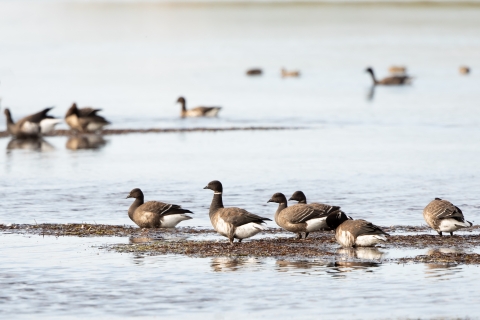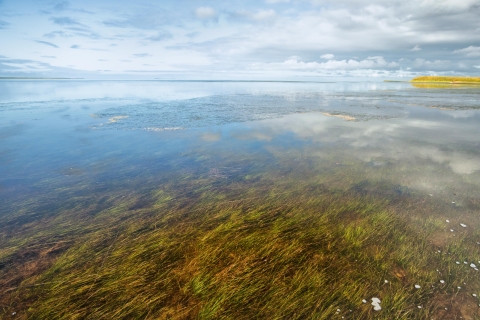Seasons of Wildlife
Coastal brown bear, caribou, fox and wolves live in the refuge year-round. Pacific salmon that return to streams each year to spawn fuel this coastal ecosystem during the summer and fall. This rich fishery provides quality forage for coastal brown bears and other predators. The Southern Alaska Peninsula Caribou Herd also inhabits the refuge. Several species of marine mammals either inhabit or pass through refuge coastal waters and lagoons. These include harbor seal, sea otter, walrus, the threatened Steller's sea lion, and gray, minke, killer and humpback whales.
Every fall, thousands of migratory waterfowl take refuge in the lagoons of the Izembek National Wildlife Refuge and State Game Refuge, including the entire population (roughly 160,000) of Pacific black brant geese. Peppered amongst emperor geese, Canada geese, and Steller’s eiders, brant annually reunite with their relatives to stage, or fatten up, on the world’s largest eelgrass beds before setting forth to their respective wintering grounds. Some will travel to protected bays along the Pacific coast of the U.S., though most are headed for Mexico’s Baja Peninsula, and an ever-growing portion—about 30%—remain in Izembek due to the warming winters.
Treeless and generally restricted to low-growing species that can withstand cool temperatures, the refuge has frequent strong winds, shallow acidic soils, and a short growing season. Pacific coastal plants predominate, although Arctic species are also common. Dominant plants include crowberry, grass, sedge, cottongrass, moss, alder, and willow. Eelgrass dominates lagoon habitats and is critically importance to waterfowl, especially Pacific black brant.



